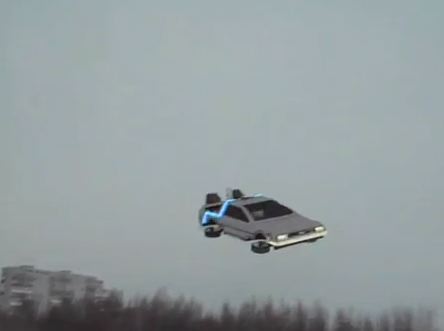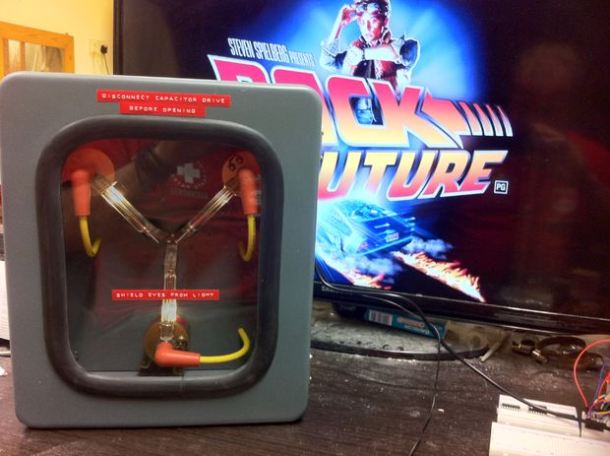Unfortunately, not all of us are lucky enough to have a time-warping DeLorean that’ll let us travel into the future at warp speed. After watching Back to the Future II, it’s safe to assume that we’ve all been waiting 30 years for October 21, 2015 to finally come — also known as the day that Marty arrives! What better way to pay homage to the ingenuity of Doc — who happens to be a Maker himself — than by compiling a list of our favorite BttF-inspired projects?
2015? You mean we’re in the future?

For anyone who grew up in the ‘80s, this display panel should look incredibly familiar. It’s the time circuit, which Doc built into his 88 mph DeLoren machine. The brainchild of Phillip Burgess, the clock consists of LED displays housed inside a metal-painted acrylic enclosure, controlled a Teesny 2.0 (ATmega32U4) that was able to fit in places that an Arduino couldn’t.
It’s a bird! It’s a plane! It’s a DeLorean drone!

Back in 2011, YouTuber Native118 decided to honor the cult classic by modding his quadcopter into a DeLorean drone. While it may not have been able to fly through time, it could however fly through the sky… and in style. Its stainless steel body was replaced with lightweight foamcore, and equipped with LED headlights and taillights. Although it even had a mini Mr. Fusion on its back, power was supplied through a LiPo battery. Aside from that, he employed a MultiWii for stabilization, a HobbyKing 12A BlueSeries speed controller and a batch of Turnigy 2204-14T motors for the engines.
Time circuit’s on! Flux capacitor, fluxing!

Just one of the many BttF props that Chris Fry hopes to replicate someday, the Maker recently devised a remote-controlled flux capacitor based on the Arduino Uno (ATmega328). The gadget features several audio tracks and lighting effects with varying modes (e.g. disco and reverse) at different speeds.
Roads? Where we’re going we don’t need roads!

With a love for the DeLorean DMC-12, one pair of Canadian Makers spent more than 600 hours creating a retro-chic BttF golf cart, which boasts speakers that emit phrases from the movie along with a capacitor controlled by an Adafruit Pro Trinket (ATmega328).
Playing the BttF theme with floppies

How do you honor the nostalgic tunes of BttF? Think McFly, think! With floppy music, of course! This is exactly what YouTuber Arganalth did. He attached a Raspberry Pi to a bunch of floppy and HDD drives, housed the entire system inside a suitcase and then programmed the drives’ mechanisms to play the famous songs. He employed a PC that sent the data to an Arduino Uno (ATmega328), plus integrated some batteries for power and portability.
When this baby hits 88mph, you’re gonna see some serious…

In the parking lot at the mall, Doc uses a remote control to drive around his time-traveling car after putting his dog (Einstein) in the driver’s seat. Resembling the original Futaba FP-T8SGA-P, Maker Todd Jones designed a mock controller with an LED counter running an Arduino, along with a sound module that’s typically found inside singing birthday cards. With a flick of a few switches, the device turns on and the display begins to count upwards to the DeLorean’s necessary 88 mph while emitting the character’s legendary phrases.
Size adjusting – fit… Drying mode on. Jacket drying.

With a desire to make Marty McFly’s auto-adjusting jacket a reality, the Instructables crew took it upon themselves to take a glimpse into what a future with self-sizing garments would look like. The team of Makers developed jacket sleeves that start off too long and then go up as if they modify itself to the correct length. This was accomplished by using a 3D-printed pulley mechanism and micro gear motors. Whenever a button on the jacket hem is pushed, cables are wound around a pulley, drawing the sleeves up. These cables are threaded through a simple tube system built inside the jacket and sleeves.
Power laces, alright!

Aside from the DeLorean and hoverboard, there’s one other notable thing from BttF that has left us eagerly waiting to get our
- Atmel Staff -

